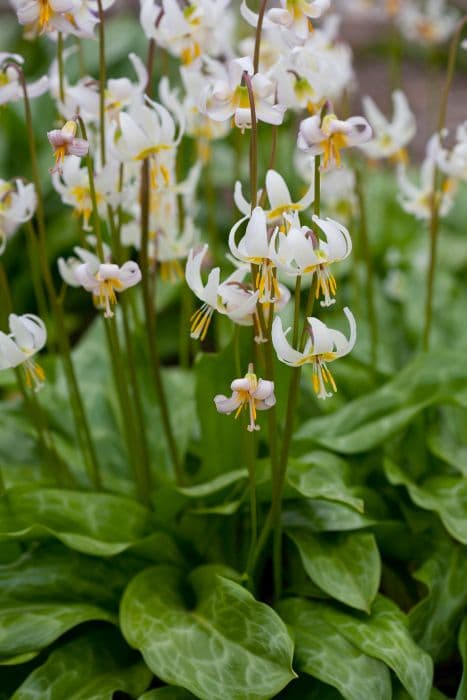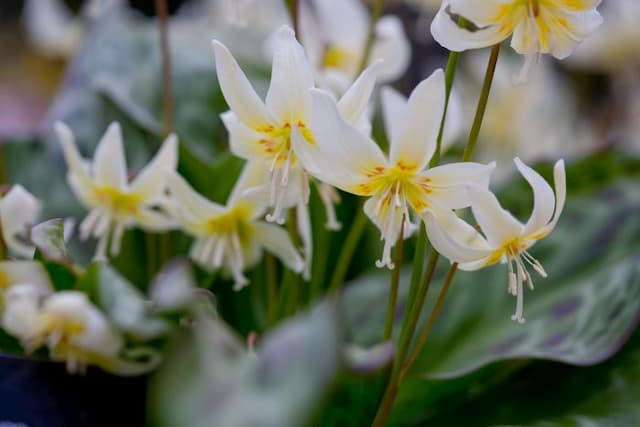Lady Tulip Tulipa clusiana var. chrysantha (15)

ABOUT
Tulipa clusiana var. chrysantha, commonly known as Lady Tulip, is a distinctive flowering plant with a graceful, elegant appearance. The Lady Tulip possesses lance-shaped leaves that are gray-green in color, providing a subtle backdrop for the bloom. The stems are sturdy, supporting the flowers well. The flowers of the Lady Tulip are particularly noteworthy, consisting of pointed petals that exhibit a striking color contrast. The outer petals are a pale yellow while the inner petals display a deeper, golden yellow hue that can catch the eye from a distance. These petals often display a delicate red or pinkish edge, adding a colorful accent to the overall appearance. The shape of the blooms is elongated and tapered, resembling a classic cup shape that opens gracefully in the sunlight. Inside the flower, the stamens and pistil are prominent, often adding contrasting colors that further enhance the visual appeal of the Lady Tulip. This plant has a tendency to open its flowers fully on sunny days, creating a star-like display that adds to its charm. Overall, the Lady Tulip is aesthetically pleasing, presenting a simple yet vibrant look in any garden setting.
About this plant
 Names
NamesFamily
Liliaceae
Synonyms
Lady Tulip, Candlestick Tulip, Clusius' Tulip
Common names
Tulipa chrysantha, Tulipa aitchisonii, Tulipa clusiana var. aitchisonii, Tulipa clusiana subsp. aitchisonii.
 Toxicity
ToxicityTo humans
The Lady Tulip is not classified as a highly toxic plant to humans, but like many members of the Liliaceae family, it can cause minor symptoms if ingested. The plant contains compounds that can be mildly toxic, and eating parts of the plant, particularly the bulbs, might cause gastrointestinal discomfort, such as nausea, vomiting, and diarrhea. There can also be skin irritation from handling the plant, especially in sensitive individuals. In any instance of suspected poisoning, medical attention is advised.
To pets
The Lady Tulip can be toxic to pets if ingested. It contains alkaloids and other compounds that can cause gastrointestinal upset, including symptoms like vomiting, drooling, or diarrhea. In severe cases, more serious symptoms such as increased heart rate and changes in breathing could occur. As with humans, the bulb is the most toxic part. If a pet ingests any part of the plant, it is important to seek veterinary care promptly.
 Characteristics
CharacteristicsLife cycle
Perennials
Foliage type
Deciduous
Color of leaves
Green
Flower color
Yellow
Height
1 feet (30 cm)
Spread
1 feet (30 cm)
Plant type
Bulb
Hardiness zones
3
Native area
Middle East
Benefits
 General Benefits
General Benefits- Ornamental Value: Tulipa clusiana var. chrysantha, commonly known as Lady Tulip, adds aesthetic appeal to gardens with its striking yellow flowers.
- Attracts Pollinators: Lady Tulips can attract bees and other pollinators to the garden, which is beneficial for the pollination of plants and overall biodiversity.
- Spring Bloom: They provide early spring color, often being among the first flowers to bloom after winter, signaling the start of the growing season.
- Diversity in Landscaping: They can be used in a variety of landscaping designs, including borders, rock gardens, and as underplanting for taller plants.
- Ease of Care: Lady Tulips are relatively easy to grow and maintain, which makes them suitable for beginner gardeners.
- Economic Value: As a popular bulb in the horticultural trade, they can be a source of income for nurseries and garden centers.
- Naturalizing: They have the capability to naturalize, or spread over time, filling spaces in the garden and reducing the need for additional planting.
- Seasonal Interest: The bulbs can provide a sequential blooming period when planted with other bulb varieties, extending the flowering season.
- Compatibility with Other Plants: Lady Tulips are compatible with a broad range of other garden plants, allowing for diverse and complementary garden designs.
- Container Growth: They are suitable for container growth, which means they can be enjoyed by those with limited garden space such as balconies or patios.
- Landscape Restoration: The bulbs can be used in restoration projects to reintroduce native plants and enhance the natural landscape.
- Educational Use: Gardening with Tulipa clusiana var. chrysantha can be used as an educational tool to teach about plant lifecycles and horticulture.
- Cultural Significance: Many tulip species have socio-cultural importance and can be used in traditional events or as symbols in art and literature.
- Culinary Use: Some species of tulips are known for their edible petals and can be used in certain culinary applications; however, ensure identification is correct as some parts can be toxic if misidentified.
- Improved Mental Well-being: Gardening activities, including planting and caring for tulips, have been associated with reduced stress and improved mental well-being.
 Medical Properties
Medical PropertiesThis plant is not used for medical purposes.
 Air-purifying Qualities
Air-purifying QualitiesThis plant is not specifically known for air purifying qualities.
 Other Uses
Other Uses- Lady Tulip bulbs can be used as a food source in times of scarcity. After careful preparation to remove toxins, the bulbs can be cooked and consumed.
- The petals of the Lady Tulip can be used in the craft of flower pounding to transfer their colors onto fabrics, creating natural patterns and designs.
- Dried Lady Tulip petals can be incorporated into potpourri mixtures to add color and a mild fragrance to a room.
- This plant is often used in educational settings to help students learn about plant biology, hybridization, and the growth cycle of bulbous plants.
- Lady Tulip can be used as a natural dye, where the petals provide a source of yellow pigment for fabrics and art projects.
- Florists sometimes use the Lady Tulip's linear leaves in flower arrangements to add a contrasting shape and texture amongst other flowers.
- Its vibrant flowers can be pressed and used in botanical art, preserving the beauty of Lady Tulip in herbarium collections.
- As a symbol of perfect love, Lady Tulip bulbs are sometimes given as wedding gifts to wish the couple a bright and happy future.
- In landscape design, Lady Tulip can be used to create a 'naturalizing' effect, as they can spread and appear as if they are growing wild in an area.
- Photographers and painters might use Lady Tulip as a subject to capture the essence of spring and the intricacies of its striking coloration.
Interesting Facts
 Feng Shui
Feng ShuiThe Lady Tulip is not used in Feng Shui practice.
 Zodiac Sign Compitability
Zodiac Sign CompitabilityThe Lady Tulip is not used in astrology practice.
 Plant Symbolism
Plant Symbolism- Perfect Love: The Tulip, in general, symbolizes perfect love, with different colors conveying different meanings within that overarching theme.
- Declaration of Love: Legend has it that the Tulip's velvety black center represents a lover's heart, darkened by the heat of passion.
- Hope and Aspiration: As a flower that emerges in spring, the Tulip often represents a sense of renewal, hope, and aspiration for the future.
- Ephemeral Beauty: Tulips bloom for a short period, reminding us of the transient nature of beauty and life's fleeting moments.
- Charisma and Charm: The bright and showy appearance of the Lady Tulip (the common name of Tulipa clusiana var. chrysantha) can symbolize a person's charismatic and charming nature.
 Water
WaterLady Tulip should be watered when the top inch of soil feels dry to touch. It's important to avoid waterlogging, so ensure good drainage. During the growing season in spring, you might find yourself watering the plant once a week, with around a half to one gallon of water per plant, depending on the size of the bulb and environmental conditions. When the plant is dormant, after the flowers and leaves have died back, reduce watering significantly. Always check soil moisture before watering to avoid overwatering which can lead to bulb rot.
 Light
LightLady Tulip thrives in full sun to partial shade. An ideal spot would be an area that receives at least six hours of direct sunlight daily. The bright, indirect light of morning or late afternoon is also suitable for these plants, as high noon sun in extremely hot climates can be a bit too intense.
 Temperature
TemperatureThe Lady Tulip can tolerate a range of temperatures but grows best when the environment is between 60 and 70 degrees Fahrenheit. It can withstand colder temps, down to about 35 degrees, during its dormant period in winter. It is crucial not to expose the bulbs to temperatures over 75 degrees for prolonged periods, as excessive heat can damage the plant and affect blooming.
 Pruning
PruningPruning Lady Tulip mainly involves deadheading spent flowers to encourage more blooms and prevent the plant from using energy to produce seeds. Cut back the stems to the base of the plant once the flowers have faded. After foliage has yellowed and died back, usually late in the season, it can be removed to maintain tidiness. Pruning is typically needed annually after blooming.
 Cleaning
CleaningAs needed
 Soil
SoilLady Tulip flourishes best in a well-draining soil mix with a pH between 6.0 and 7.0. Combine sandy loam or a mix of equal parts sand, silt, and clay, with a bit of compost to add nutrients. Avoid heavy, water-logging soils to prevent bulb rot.
 Repotting
RepottingLady Tulips are typically repotted only when necessary, about every three to five years. They should be repotted after the foliage has died back post-flowering to give the bulbs a chance to rest.
 Humidity & Misting
Humidity & MistingLady Tulips prefer moderate humidity levels but are quite adaptable. They thrive outdoors and do not require specific humidity adjustments when grown in their natural climate.
 Suitable locations
Suitable locationsIndoor
Place Lady Tulip in bright, indirect light and keep soil moderately dry.
Outdoor
Plant bulbs in the fall in well-draining soil and full sun.
Hardiness zone
3-8 USDA.
 Life cycle
Life cycleTulipa clusiana var. chrysantha, commonly known as Lady Tulip, begins its life cycle with the germination of seeds or the growth of underground bulbs when conditions become favorable, typically in the fall. The bulbs send up shoots, which develop into long, slender leaves and a single flower stalk in early spring. The flower blooms revealing typically yellow or red petals, which, after pollination by insects, may produce seeds. Following the flowering and seed dispersal, the above-ground foliage starts to wither as the plant enters a dormancy phase during the hot summer months. The bulb remains dormant underground, storing energy for the next growth cycle. With the return of cooler temperatures and autumn rains, the cycle restarts with bulb growth and new shoot development.
 Propogation
PropogationPropogation time
Spring
Tulipa clusiana var. chrysantha, commonly known as Lady Tulip, is typically propagated by dividing the bulbs. The most popular and effective time to propagate these bulbs is in the fall, after the leaves have died back and the plant is dormant. In this process, the mature bulb is gently lifted from the soil using a trowel or garden fork after the foliage has yellowed and died back. Care is taken to avoid damaging the bulbs during lifting. The offsets, which are smaller bulbs attached to the main bulb, are gently separated and can be replanted immediately. Each offset should be planted at a depth approximately three times the height of the bulb, usually between 4 to 6 inches (10 to 15 centimeters) deep, depending on the size of the bulb. The soil is then firmed gently, and the site is watered to settle the soil.








